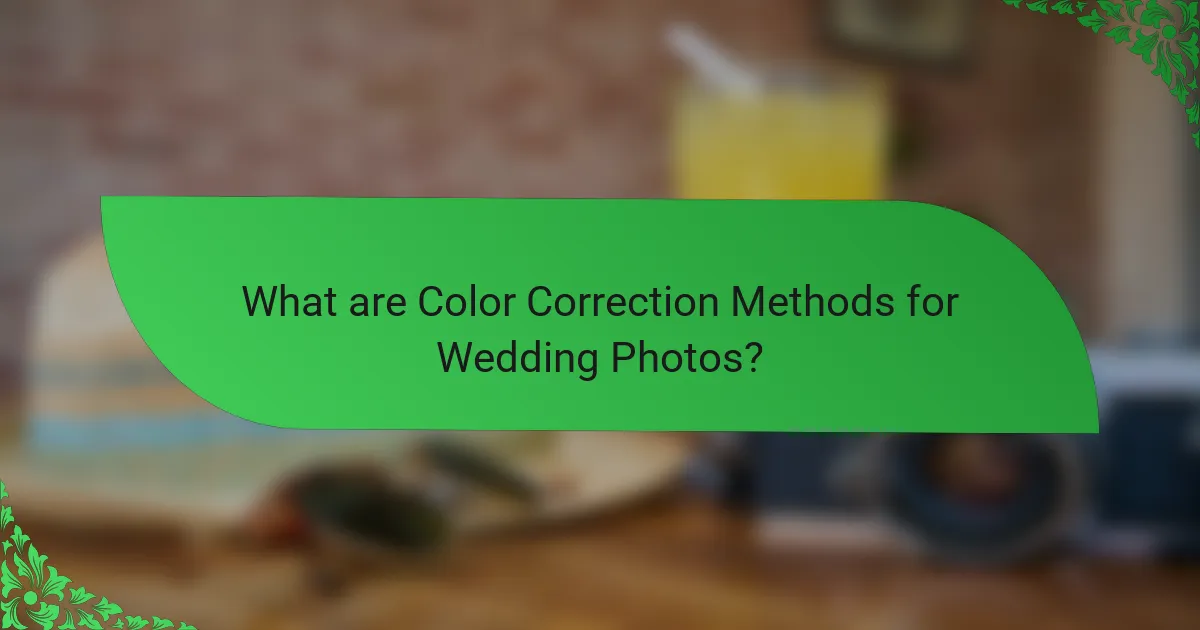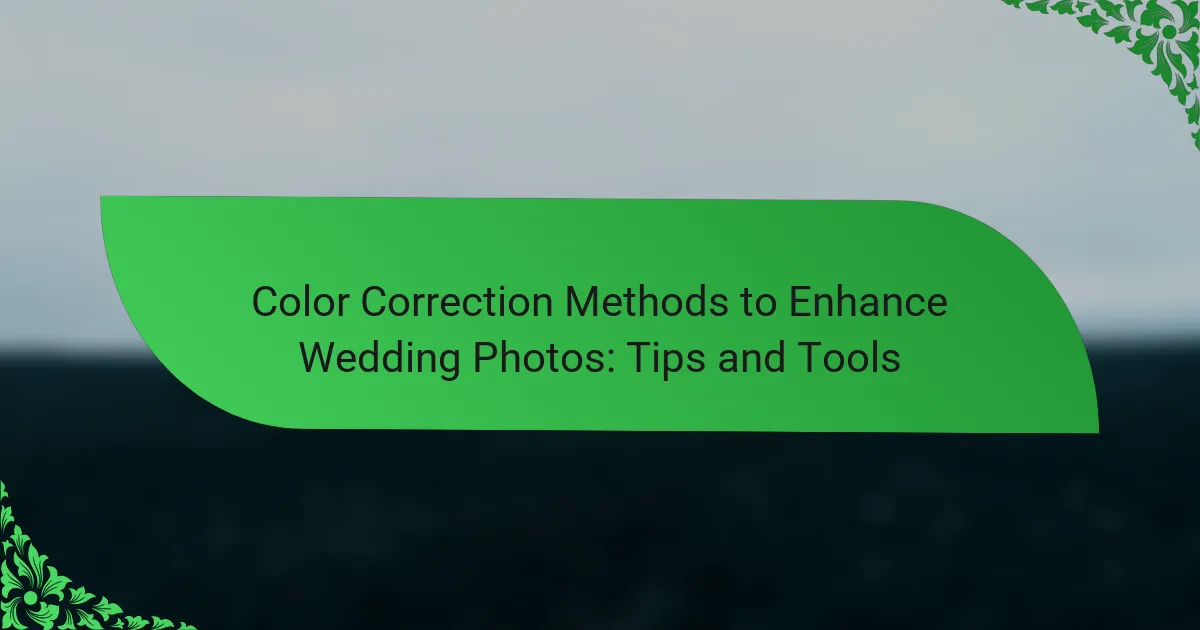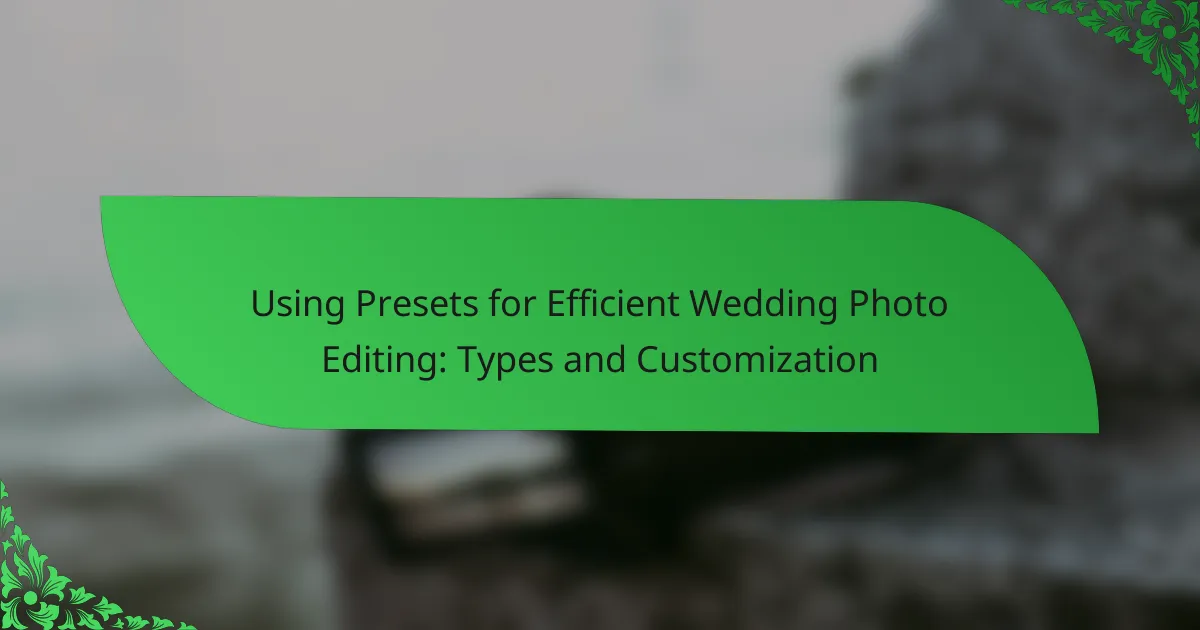Color correction methods are essential for enhancing wedding photos, focusing on key adjustments such as exposure, white balance, and saturation. Exposure correction balances brightness levels, while white balance adjustment ensures natural skin tones by eliminating color casts. Saturation correction modifies color intensity to achieve the desired visual effect. Techniques like curves, levels, and color grading, along with software tools such as Adobe Lightroom and Photoshop, allow photographers to refine their images. The use of presets is common for maintaining consistency across wedding photographs, ultimately improving their visual quality significantly.

What are Color Correction Methods for Wedding Photos?
Color correction methods for wedding photos include adjusting exposure, white balance, and saturation. Exposure correction ensures that images are neither too bright nor too dark. White balance adjustment removes color casts and makes skin tones appear natural. Saturation correction enhances or reduces color intensity to achieve the desired look. Techniques such as using curves, levels, and color grading can refine the overall aesthetic. Software like Adobe Lightroom and Photoshop provides tools for these adjustments. Photographers often use presets for consistency across images. These methods enhance the visual quality of wedding photographs significantly.
How do color correction methods improve wedding photography?
Color correction methods enhance wedding photography by ensuring accurate color representation and improving overall image quality. These methods adjust colors to match natural lighting conditions and skin tones. They also correct color casts caused by different light sources. This results in photos that feel more authentic and visually pleasing. Additionally, color correction can enhance specific elements, such as flowers or decorations, making them pop. Consistent color grading across images creates a cohesive look for wedding albums. Studies show that well-edited images can increase viewer engagement and emotional response. Thus, effective color correction is essential for capturing the essence of wedding moments.
What are the key principles of color correction in photography?
The key principles of color correction in photography include understanding color balance, adjusting exposure, and utilizing color grading. Color balance ensures accurate representation of colors in an image. Adjusting exposure involves correcting brightness levels for optimal visibility. Color grading enhances the mood and aesthetic by applying specific color tones. These principles help achieve a cohesive and visually appealing final image. Proper color correction techniques can significantly improve the overall quality of wedding photos.
How does color theory apply to wedding photo enhancement?
Color theory applies to wedding photo enhancement by guiding the selection and manipulation of colors to evoke emotions. Understanding color harmony helps photographers create visually appealing images. Complementary colors can enhance focal points in wedding photos. Analogous colors create a serene and cohesive look. The use of warm and cool tones can influence the mood of the image. For instance, warm tones can evoke happiness and intimacy, while cool tones can suggest calmness. Color grading techniques often rely on color theory principles to achieve desired effects. This approach leads to more engaging and memorable wedding photographs.
What tools are available for color correction in wedding photography?
Available tools for color correction in wedding photography include software and plugins. Popular software includes Adobe Lightroom, which offers advanced color grading and correction features. Adobe Photoshop is also widely used for detailed adjustments. Capture One is another professional-grade option known for its color accuracy.
Plugins like Nik Collection enhance editing capabilities within existing software. Color grading tools within these platforms allow photographers to adjust hues, saturation, and contrast. Many tools provide presets for quick adjustments based on lighting conditions.
These tools are essential for achieving vibrant and true-to-life colors in wedding photos.
Which software options are most popular for color correction?
Adobe Premiere Pro, DaVinci Resolve, and Final Cut Pro are the most popular software options for color correction. Adobe Premiere Pro offers extensive color grading tools and integrates well with other Adobe products. DaVinci Resolve is renowned for its advanced color grading capabilities and is widely used in the film industry. Final Cut Pro is favored by Mac users for its user-friendly interface and powerful color correction features. These software options are commonly used by professionals to achieve high-quality color correction in various video projects.
What are the essential features to look for in color correction tools?
Essential features to look for in color correction tools include user-friendly interfaces, advanced color grading options, and precise color matching capabilities. User-friendly interfaces facilitate easy navigation, allowing users to focus on editing rather than struggling with the software. Advanced color grading options enable users to manipulate shadows, midtones, and highlights effectively. Precise color matching capabilities help ensure consistency across different images, which is crucial for wedding photography. Additionally, real-time previews allow users to see changes instantly. Support for various file formats enhances compatibility with different camera systems. Integration with other editing software can streamline workflows. Finally, robust tutorials and customer support can assist users in maximizing the tool’s potential.
What techniques are commonly used in color correction for wedding photos?
Common techniques used in color correction for wedding photos include white balance adjustment, exposure correction, and saturation enhancement. White balance adjustment ensures accurate color representation by correcting color casts. Exposure correction adjusts the brightness to achieve the desired light levels in images. Saturation enhancement boosts the intensity of colors, making them more vibrant. Additionally, curves and levels adjustments fine-tune contrast and tonal range. Color grading can also be applied to create a specific mood or style. Using these techniques, photographers can significantly improve the overall aesthetic of wedding images.
How do you adjust white balance effectively in wedding photos?
To adjust white balance effectively in wedding photos, use the camera’s white balance settings. Start by selecting the appropriate white balance preset based on the lighting conditions. For example, use “Daylight” for outdoor settings and “Tungsten” for indoor venues with incandescent lights.
Next, consider using a gray card to achieve accurate white balance. Capture a photo of the gray card in the same lighting as the subjects. This provides a reference point for post-processing adjustments.
In editing software, use the eyedropper tool to click on a neutral area in the photo. This will automatically adjust the white balance to neutralize color casts.
Monitor the histogram to ensure the colors are balanced. A properly adjusted white balance will show a balanced histogram without color spikes on either end.
Finally, review the image on different devices to confirm the white balance appears consistent across platforms. This method ensures that skin tones are rendered accurately in wedding photos.
What is the role of color grading in enhancing wedding images?
Color grading plays a crucial role in enhancing wedding images. It adjusts the colors and tones to create a specific mood or atmosphere. This technique can make images appear more vibrant or soft, depending on the desired effect. Color grading also helps in maintaining consistency across a series of photos. It can correct color imbalances caused by lighting conditions during the event. Additionally, it emphasizes important details and subjects, drawing the viewer’s attention. By using color grading, photographers can evoke emotions and enhance the storytelling aspect of the wedding. Overall, it significantly improves the visual appeal of wedding photographs.
How can you transition from basic to advanced color correction methods?
To transition from basic to advanced color correction methods, start by mastering the fundamentals. Understand color theory and how to manipulate the color wheel effectively. Use software tools like Adobe Lightroom or Photoshop to practice basic adjustments. Gradually incorporate advanced techniques such as color grading and selective color adjustments. Explore the use of curves and levels for precise tonal control. Familiarize yourself with LUTs (Look-Up Tables) for consistent color grading across images. Study professional workflows and analyze how experienced photographers edit their work. Finally, seek feedback on your edits to refine your skills.
What are the best practices for achieving consistent color correction?
Use a calibrated monitor for accurate color representation. This ensures that colors are displayed correctly during editing. Consistent lighting conditions are essential during photo shoots. This helps maintain uniformity in color tones. Utilize color grading tools in post-processing software. These tools allow for precise adjustments to color balance and saturation. Create and apply presets for similar lighting conditions. This saves time and ensures uniformity across images. Regularly compare edits against reference images. This practice helps maintain consistency in color correction. Finally, perform quality checks on multiple devices. Different screens can display colors differently, so verify consistency across platforms.
What common mistakes should be avoided in color correction for wedding photos?
Common mistakes to avoid in color correction for wedding photos include over-saturation of colors. This can lead to unnatural skin tones. Another mistake is inconsistent color grading across different photos. This can disrupt the visual flow of the wedding album. Failing to adjust white balance correctly is also a frequent error. Incorrect white balance can make images appear too warm or too cool. Additionally, neglecting to use proper color profiles can result in color shifts during printing. Lastly, overusing filters can detract from the authenticity of the images. Each of these mistakes can significantly impact the overall quality of wedding photos.
How can over-editing affect the final look of wedding photos?
Over-editing can significantly distort the final look of wedding photos. It may lead to unnatural skin tones that appear overly smooth or plastic. Excessive contrast adjustments can create harsh shadows and highlights. This can detract from the romantic feel typically desired in wedding photography. Over-saturation can result in colors that look unrealistic and garish. It can also obscure important details in the images. A balance in editing is essential to maintain authenticity. Many photographers recommend a light touch to enhance rather than alter the original scene.
What are the signs of poor color correction in wedding photography?
Signs of poor color correction in wedding photography include unnatural skin tones. Skin may appear overly red, orange, or green. Images can also show inconsistent color balance across different photos. This inconsistency leads to a disjointed look in the wedding album. Additionally, overly saturated colors can make the images look unrealistic. Conversely, desaturated images can appear dull and lifeless. Poor color correction can also result in loss of detail in highlights and shadows. This loss can affect the overall quality and aesthetic appeal of the photographs.
What tips can help photographers enhance wedding photos through color correction?
Photographers can enhance wedding photos through color correction by adjusting white balance, saturation, and contrast. Correcting white balance helps achieve accurate skin tones and natural colors. Photographers should use tools like the eyedropper tool in editing software to set the correct temperature. Increasing saturation can make colors more vibrant, but it should be done carefully to avoid oversaturation. Adjusting contrast adds depth and dimension to images. Photographers can use histograms to guide these adjustments. Using presets can also streamline the color correction process while maintaining consistency. Regularly comparing edits to the original photo ensures the enhancements are effective.
Color correction methods for wedding photos involve techniques such as adjusting exposure, white balance, and saturation to enhance image quality and achieve accurate color representation. Key principles include understanding color balance, utilizing color grading, and employing tools like Adobe Lightroom and Photoshop for effective adjustments. The article also covers common mistakes to avoid, best practices for consistency, and the role of color theory in photo enhancement. By mastering these methods, photographers can create visually appealing wedding albums that resonate emotionally with viewers.



